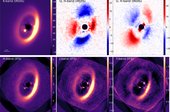 IIA SWASTIK, C
IIA SWASTIK, CPDS 70 unveiled by star-hopping: Total intensity, polarimetry, and millimeter imaging modeled in concert
Context. Most ground-based direct-imaging planet search campaigns use angular differential imaging that distorts the signal from extended sources, such as protoplanetary disks. In the case of the young system PDS 70, for which two planets were detected within the cavity of a protoplanetary disk, obtaining a reliable image of both planets and the disk is essential to understanding planet-disk interactions. Aims. Our goals are to reveal the true intensity of the planets and disk without self-subtraction effects for the first time, search for new giant planets beyond separations of 0.1″, and to study the morphology of the disk shaped by two massive planets. Methods. We present YJHK-band imaging, polarimetry, and spatially resolved spectroscopy of PDS 70 using near-simultaneous reference star differential imaging, also known as star-hopping. We created a radiative transfer model of the system to try to match the near-infrared imaging and polarimetric data within measurement errors. Sub-millimeter imaging data from ALMA were also modeled. Furthermore, we extracted the spectra of the planets and the disk and compared them Results. With strong constraints, we find that the disk is quite flared, with a scale height of ∼15 at the outer edge of the disk at ∼90 au, similar to some disks in the literature. The gap inside ∼50 au is estimated to have ∼1 of the dust density of the outer disk. The northeast outer disk arc seen in previous observations is likely the outer lip of the flared disk. Abundance ratios of sub-micron, micron, and grains estimated by the modeling indicate a shallow grain-size index greater than −2.7, instead of the canonical –3.5. There is both vertical and radial segregation of grains. Planet c is well separated from the disk and has a spectrum similar to planet b, and it is clearly redder than the disk spectra. Planet c is possibly associated with the sudden flaring of the disk starting at ∼50 au. We found no new planets in the system. If we assume DUSTY models and an age of 5 Myr, this indicates no new planets more massive than 5 outside a 12 au separation.
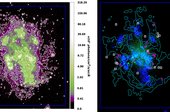 IIA SAFONOVA, M
IIA SAFONOVA, MAstroSat/UVIT Study of the Diffuse Ultraviolet Radiation in the Dwarf Galaxy Holmberg II
We present measurements of diffuse ultraviolet (UV) emission in the dwarf irregular galaxy Holmberg II obtained with the Ultra Violet Imaging Telescope (UVIT) instrument onboard AstroSat, India's first multiwavelength space mission. With a spatial resolution of 1farcs2–1farcs6, these are the highest resolution UV observations of the galaxy to date. We find that diffuse emission accounts for ∼70.6% of the total far-ultraviolet (FUV) and for ~58.1% of the total near-ultraviolet (NUV) emission. In the FUV, this is reasonably close to the fraction reported for the SMC bar. We perform a UV–IR correlation study of the diffuse emission in this galaxy using infrared (IR) observations from the Spitzer Space Telescope and Herschel Space Observatory for selected locations, free of detectable bright point sources. The strongest positive correlation between FUV and IR is observed at 70 μm for high H i density (N(H i) > 1 × 1021 cm−2) locations, indicating that warm dust grains dominate the IR emission, in agreement with earlier studies, while NUV is better correlated with 160 μm emission associated with cold dust grains. Low H i density regions (N(H i) < 1 × 1021 cm−2), or cavities, do not show any significant UV–IR correlation except at 160 μm, implying either the presence of colder dust grains in cavities being irradiated by the general radiation field, or insufficient amount of dust. The dust scattering contribution in high H i density regions, estimated using a single scattering model with foreground dust clouds with LMC reddening, gives best-fit albedo and asymmetry factor values of α = 0.2 and g = 0.5, respectively, in reasonable agreement with the theoretical predictions for LMC dust. Our model-derived scattering optical depths in the FUV range from 0.02 to 0.12, implying the medium is optically thin. Therefore, in high H i density regions, dust scattering can be one of the sources of the observed diffuse UV emission, apart from possible contributions from H2 fluorescence. However, the diffuse UV component in H i cavities can only be explained via other mechanisms, such as two-photon emission.
 IIA SASIKUMAR RAJA, K
IIA SASIKUMAR RAJA, KLow-frequency solar radio type II bursts and their association with space weather events during the ascending phase of solar cycle 25
Type II solar radio bursts are signatures of the coronal shocks and, therefore, particle acceleration events in the solar atmosphere and interplanetary space. Type II bursts can serve as a proxy to provide early warnings of incoming solar storm disturbances, such as geomagnetic storms and radiation storms, which may further lead to ionospheric effects. In this article, we report the first observation of 32 type II bursts by measuring various plasma parameters that occurred between May 2021 and December 2022 in solar cycle 25. We further evaluated their accompanying space weather events in terms of ionospheric total electron content (TEC) enhancement using the rate of TEC index (ROTI). In this study, we find that at heliocentric distance ∼1–2 R⊙, the shock and the Alfvén speeds are in the range 504–1282 and 368–826 km‑1, respectively. The Alfvén Mach number is of the order of 1.2≤MA≤1.8 at the above-mentioned heliocentric distance. In addition, the measured magnetic field strength is consistent with the earlier reports and follows a single power law B(r)=6.07r-3.96G. Based on the current analysis, it is found that 19 out of 32 type II bursts are associated with immediate space weather events in terms of radio blackouts and polar cap absorption events, making them strong indications of space weather disruption. The ROTI enhancements, which indicate ionospheric irregularities, strongly correlate with GOES X-ray flares, which are associated with the type II radio bursts recorded. The diurnal variability in ROTI is proportional to the strength of the associated flare class, and the corresponding longitudinal variation is attributed to the difference in longitude. This article demonstrates that since type II bursts are connected to space weather hazards, understanding various physical parameters of type II bursts helps to predict and forecast the space weather.
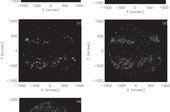 IIA RAVINDRA, B
IIA RAVINDRA, BEquator to Pole Solar Chromospheric Differential Rotation Using Ca-K Features Derived from Kodaikanal Data
Differential rotation is one of the basic characteristics of the Sun, and it plays an important role in generating the magnetic fields and its activities. We investigated rotation rate using chromospheric features such as plages, enhanced network (EN), active network (AN), and quiet network (QN) separately (for the first time). The digitized Ca-K images from Kodaikanal Observatory for 1907–1996 are used to study rotation over 0°–80° latitudes at an interval of 10°. We find that plages and all types of networks exhibit the differential rotation of the chromosphere. Furthermore, the rotation rate shows a decreasing pattern as one move from the equator to the higher polar latitudes for all the features used in the study. At the equator the rotation rate (rotation period) is obtained to be ∼13.98° day−1 (25.74 days), ∼13.91° day−1 (25.88 days), ∼13.99° day−1 (25.74 days), and ∼14.11° day−1 (25.51 days) for plage, EN, AN, and QN areas, respectively. By analyzing how the area of chromospheric features varies over time, we can effectively map the Sun's rotation rate at all latitudes, including the polar regions. Interestingly, both plages and small-scale networks exhibit a similar differential rotation rate. This suggests these features likely rooted at the same layer below the visible surface of the Sun. Therefore, the long-term Ca-K data is very useful for studying the solar rotation rate at all latitudes including the polar regions.
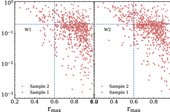
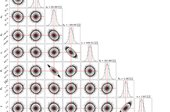 IIA DHANUSH, S. R
IIA DHANUSH, S. RA Comprehensive Kinematic Model of the Large Magellanic Cloud Disk from Star Clusters and Field Stars using Gaia DR3: Tracing the Disk Characteristics, Rotation, Bar, and Outliers
The internal kinematics of the Large Magellanic Cloud (LMC) disk have been modeled by several studies using different tracers with varying coverage, resulting in a range of parameters. Here, we model the LMC disk using 1705 star clusters and field stars, based on a robust Markov Chain Monte Carlo method, using Gaia DR3 data. The dependency of the model parameters on the age, coverage, and strength of the clusters are also presented. This is the first comprehensive 2D kinematic study using star clusters. Red clump (RC) stars and young main-sequence stars are also modeled for comparison. The clusters and field stars are found to have distinctly different kinematic centers, disk inclination, position angle of the line of nodes, and scale radius. We also note a significant radial variation of the disk parameters. Clusters and young stars are found to have a large residual proper motion and a relatively large velocity dispersion when compared to the RC field population, which could be due to perturbation from the bar and spiral arms. We trace the presence of the large residual proper motion and noncircular motion among clusters likely to be due to the bar and detect a decrease in the scale radius as a result of the possible evolution of the bar. The kinematically deviant clusters point to a spatiotemporal disturbance in the LMC disk, matching with the expected impact factor and time of the recent collision between the LMC and the Small Magellanic Cloud.
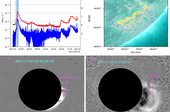 IIA SASIKUMAR RAJA, K
IIA SASIKUMAR RAJA, KAn Assessment of Solar Cycle 25 progress through observation of SRBs and associated Geomagnetic Storms
Geomagnetic storms are severe aspects of Space Weather. They originate due to solar transient emissions such as coronal mass ejections (CMEs), whose energetic materials propagate in the Interplanetary medium and are coupled with the magnetosphere system. CME driven Geomagnetic storms are often associated with solar radio bursts (SRBs), particularly type II and type IV bursts. In this study, we present the preliminary results of solar radio observations and their associated geomagnetic activity during solar cycle 25 (SC 25) from January 2020 to June 2023, focusing on the cycle’s first four intense geomagnetic storms. The study used various radio telescopes, mainly the compound astronomical low-frequency low-cost instrument for spectroscopy and transportable observatory (CALLISTO), as well as OMNI data and the World Data Center for Geomagnetism. During the study period, it was found that 23 solar radio bursts diagnosed the geomagnetic storms with Dst < -50nT from 35 reported, including three severe storms of the SC 25. The time delay between the solar radio bursts and the arrival of CMEs and/or HSS near the Earth’s magnetosphere is estimated with an average value of 79 h within the [48–120 h] range for 23 geomagnetic storms associated with solar radio bursts. Among 35 geomagnetic storms recorded, five are recurring geomagnetic storms associated with coronal high-speed streams (HSS), while CMEs cause the rest with average speeds of 750 km/s. The current SC 25 recognizes four major storms within the scope of the study. On 21 April 2023, a type II radio burst followed by a type IV burst diagnosed the first severe geomagnetic storm on 24 April 2023. The second severe storm was unusual and detected in the absence of the precursor as a solar radio burst. The SRBs of type II burst and type IV burst extending in IP medium on 1 November 2021 tracked the third major storm of the cycle while the group of type III radio bursts, type II and type IV bursts on 24 February 2023, predicted the major storm on 27 February 2023. These major geomagnetic storms are linked to CMEs that show expanding flux ropes, which are signatures of type II and moving type IV radio bursts identified. Furthermore, the detected SRBs and related major geomagnetic storms are proof of high solar and magnetic activity of the ascending phase of SC 25. The SC 25 has been characterized overall, and its current progress is being tracked using observations of SRBs and magnetic activity during its rising phase.
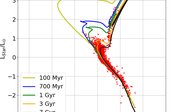 IIA RAVINDER K. BANYAL
IIA RAVINDER K. BANYALAge Analysis of Extrasolar Planets: Insight from Stellar Isochrone Models
There is growing evidence from stellar kinematics and galactic chemical evolution suggesting that giant planets (MP 0.3MJ) are relatively young compared to the most commonly occurring population of small planets (MP < 0.3MJ). To further test the validity of these results, we analyzed the ages for a large number of 2336 exoplanet hosting stars determined using three different but well-established isochrone fitting models, namely, PARSEC, MIST, and Yonsei Yale. As input parameters, we used Gaia DR3 parallaxes, magnitudes, and photometric temperature, as well as spectroscopically determined more accurate temperatures and metallicities from the Sweet Catalog. Our analysis suggests that ∼50%–70% of stars with planets are younger than the Sun. We also find that, among the confirmed exoplanetary systems, stars hosting giant planets are even younger compared to small planet hosts. The median age of ∼2.61–3.48 Gyr estimated for the giant planet-hosting stars (depending on the model input parameters) suggests that the later chemical enrichment of the galaxy by the iron-peak elements, largely produced from Type Ia supernovae, may have paved the way for the formation of gas giants. Furthermore, within the giant planet population itself, stars hosting hot Jupiters (orbital period 10 days) are found to be younger compared to the stellar hosts of cool and warm Jupiters (orbital period >10 days), implying that hot Jupiters could be the youngest systems to emerge in the progression of planet formation.
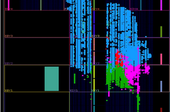 IIA PHANINDRA, D. V. S
IIA PHANINDRA, D. V. SSolarAccel: FPGA accelerated 2D cross-correlation of digital images: Application to solar adaptive optics
The cross-correlation of two-dimensional digital images is fundamental to solar adaptive optics computations. It can be used in a simple tip-tilt correction system to identify the relative shift between consecutive images and correlating sub-aperture images of a Shack–Hartmann wave-front sensor. The typical frequency of computation is about 1 kHz. While the software-based optimized cross-correlations may be sufficient when a small number of sub-apertures are used in a wave-front sensor, hardware-accelerated (FPGA), correlations may be required when a large number of sub-aperture images are involved, e.g., in the case of the proposed National Large Solar Telescope in India. This paper presents SolarAccel: An FPGA-based acceleration of a basic two-dimensional cross-correlation of two images. We accelerate the FPGA-based design by pipelining the individual components of the cross-correlation process. We implemented our RTL logic on a few sets of 128 X 128 pixel images and 32 X 32 pixel images on a Xilinx Zynq Ultrascale + MPSoC on the ZCU104 FPGA evaluation platform. SolarAccel performs a 2D FFT 128 X 128 on a image faster than existing work. The cross-correlation on a 32 X 32 image is also faster than the existing work. This demonstrates that FPGA acceleration is beneficial in solar adaptive optics applications.
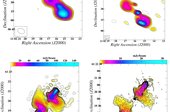 IIA NAYANA, A. J
IIA NAYANA, A. JA VLBA-uGMRT search for candidate binary black holes: study of six X-shaped radio galaxies with double-peaked emission lines
Identifying methods to discover dual active galactic nucleus (AGN) has proven to be challenging. Several indirect tracers have been explored in the literature, including X/S-shaped radio morphologies and double-peaked (DP) emission lines in the optical spectra. However, the detection rates of confirmed dual AGN candidates from the individual methods remain extremely small. We search for binary black holes (BBH) in a sample of six sources that exhibit both X-shaped radio morphology and DP emission lines using the Very Long Baseline Array (VLBA). Three out of the six sources show dual VLBA compact components, making them strong candidates for BBH sources. In addition, we present deep uGMRT images revealing the exquisite details of the X-shaped wings in three sources. We present a detailed precession modeling analysis of these sources. The black hole separations estimated from the simplistic geodetic precession model are incompatible with those estimated from emission line offsets and the VLBA separations. However, precession induced by a non-coplanar secondary black hole is a feasible mechanism for explaining the observed X-shaped radio morphologies and the black hole separations estimated from other methods. The black hole separations estimated from the double-peaked emission lines agree well with the VLBA compact component separations. Future multifrequency VLBA observations will be critical in ruling out or confirming the BBH scenario in the three galaxies with dual component detections.